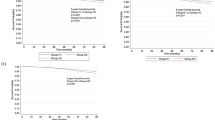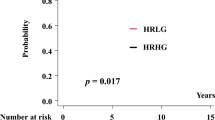Abstract
BACKGROUND:
Recently, a new prostate cancer (PC) grading system has been introduced, where Gleason score (GS) 7 (3+4) and GS 7 (4+3) are categorized into two separate groups. However, GS 7 with tertiary Gleason pattern 5 (TGP5) was not incorporated in the new grading system. In the present study, we validated the prognostic role of TGP5 in the new classification.
METHODS:
We retrospectively reviewed the records of 1396 patients with localized GS 6–8 PC (pT2-3N0M0) who underwent radical prostatectomy at our institution between 2005 and 2014. After excluding patients who received neoadjuvant or adjuvant therapy, or had incomplete pathological or follow-up data, 1229 patients were included in the final analysis. The Kaplan–Meier method was used to estimate and compare the probabilities of biochemical recurrence (BCR). Cox regression models were used to investigate associations between variables and the risk of BCR.
RESULTS:
Of 732 GS 7 patients, 75 (10.2%) had a TGP5. The BCR-free survival rate for men with TGP5 was significantly worse than for those without TGP5 (P<0.001). In multivariate Cox regression analyses for GS 7 PC, TGP5 was a significant predictor of BCR (hazard ratio 1.750, P=0.027). When the total cohort was stratified into four grade groups according to the new classification, group 2 with TGP5 had a BCR risk comparable to group 3, and group 3 with TGP5 behaved like group 4.
CONCLUSIONS:
Our study shows that TGP5 increased the BCR risk after RP in GS 7 PC. Moreover, we demonstrated that the presence of a TGP5 in GS 7 upgraded the BCR risk to one comparable with the next higher category under the new classification. These findings support incorporating TGP5 into GS 7 to aid with future risk assessment and follow-up scheduling for PC.
This is a preview of subscription content, access via your institution
Access options
Subscribe to this journal
Receive 4 print issues and online access
$259.00 per year
only $64.75 per issue
Buy this article
- Purchase on Springer Link
- Instant access to full article PDF
Prices may be subject to local taxes which are calculated during checkout



Similar content being viewed by others
References
Mellinger GT, Gleason D, Bailar J 3rd . The histology and prognosis of prostatic cancer. J Urol 1967; 97: 331–337.
Gleason DF, Mellinger GT . Prediction of prognosis for prostatic adenocarcinoma by combined histological grading and clinical staging. J Urol 1974; 111: 58–64.
Isbarn H, Ahyai SA, Chun FK, Budaus L, Schlomm T, Salomon G et al. Prevalence of a tertiary Gleason grade and its impact on adverse histopathologic parameters in a contemporary radical prostatectomy series. Eur Urol 2009; 55: 394–401.
Trock BJ, Guo CC, Gonzalgo ML, Magheli A, Loeb S, Epstein JI . Tertiary Gleason patterns and biochemical recurrence after prostatectomy: proposal for a modified Gleason scoring system. J Urol 2009; 182: 1364–1370.
Adam M, Hannah A, Budaus L, Steuber T, Salomon G, Michl U et al. A tertiary Gleason pattern in the prostatectomy specimen and its association with adverse outcome after radical prostatectomy. J Urol 2014; 192: 97–101.
Cronin AM, Godoy G, Vickers AJ . Definition of biochemical recurrence after radical prostatectomy does not substantially impact prognostic factor estimates. J Urol 2010; 183: 984–989.
Servoll E, Saeter T, Vlatkovic L, Lund T, Nesland J, Waaler G et al. Impact of a tertiary Gleason pattern 4 or 5 on clinical failure and mortality after radical prostatectomy for clinically localised prostate cancer. BJU Int 2012; 109: 1489–1494.
Leng YH, Lee WJ, Yang SO, Lee JK, Jung TY, Kim YB . Oncologic outcomes of patients with Gleason score 7 and tertiary Gleason pattern 5 after radical prostatectomy. Korean J Urol 2013; 54: 587–592.
Humphrey PA, Moch H, Cubilla AL, Ulbright TM, Reuter VE . The 2016 WHO Classification of Tumours of the Urinary System and Male Genital Organs-Part B: Prostate and Bladder Tumours. Eur Urol 2016; 70: 106–119.
Epstein JI, Egevad L, Amin MB, Delahunt B, Srigley JR, Humphrey PA et al. The 2014 International Society of Urological Pathology (ISUP) Consensus Conference on Gleason Grading of Prostatic Carcinoma: Definition of Grading Patterns and Proposal for a New Grading System. Am J Surg Pathol 2016; 40: 244–252.
Edge SB BD, Compton CC, Fritz AG, Greene FL, Trotti A . AJCC Cancer Staging Manual, 7th edn. Springer: New York, NY, USA, 2010.
Shin SJ, Park CK, Park SY, Jang WS, Lee JY, Choi YD et al. Total intraglandular and index tumor volumes predict biochemical recurrence in prostate cancer. Virchows Arch 2016; 469: 305–312.
Epstein JI, Allsbrook WC Jr, Amin MB, Egevad LL, Committee IG . The 2005 International Society of Urological Pathology (ISUP) Consensus Conference on Gleason Grading of Prostatic Carcinoma. Am J Surg Pathol 2005; 29: 1228–1242.
Ruijter ET, Miller GJ, Aalders TW, van de Kaa CA, Schalken JA, Debruyne FM et al. Rapid microwave-stimulated fixation of entire prostatectomy specimens. Biomed-II MPC Study Group. J Pathol 1997; 183: 369–375.
Lucca I, Shariat SF, Briganti A, Lotan Y, Roehrborn CG, Montorsi F et al. Validation of tertiary Gleason pattern 5 in Gleason score 7 prostate cancer as an independent predictor of biochemical recurrence and development of a prognostic model. Urol Oncol 2015; 33: e21–e76.
Sim HG, Telesca D, Culp SH, Ellis WJ, Lange PH, True LD et al. Tertiary Gleason pattern 5 in Gleason 7 prostate cancer predicts pathological stage and biochemical recurrence. J Urol 2008; 179: 1775–1779.
Epstein JI, Zelefsky MJ, Sjoberg DD, Nelson JB, Egevad L, Magi-Galluzzi C et al. A contemporary prostate cancer grading system: a validated alternative to the Gleason score. Eur Urol 2016; 69: 428–435.
Stephenson AJ, Kattan MW, Eastham JA, Dotan ZA, Bianco FJ Jr, Lilja H et al. Defining biochemical recurrence of prostate cancer after radical prostatectomy: a proposal for a standardized definition. J Clin Oncol 2006; 24: 3973–3978.
Imnadze M, Sjoberg DD, Vickers AJ . Adverse pathologic features at radical prostatectomy: effect of preoperative risk on oncologic outcomes. Eur Urol 2016; 69: 143–148.
Johansson JE, Andren O, Andersson SO, Dickman PW, Holmberg L, Magnuson A et al. Natural history of early, localized prostate cancer. JAMA 2004; 291: 2713–2719.
Freedland SJ, Humphreys EB, Mangold LA, Eisenberger M, Dorey FJ, Walsh PC et al. Risk of prostate cancer-specific mortality following biochemical recurrence after radical prostatectomy. JAMA 2005; 294: 433–439.
Pound CR, Partin AW, Eisenberger MA, Chan DW, Pearson JD, Walsh PC . Natural history of progression after PSA elevation following radical prostatectomy. JAMA 1999; 281: 1591–1597.
Acknowledgements
This study was supported by a grant from the Korean Foundation for Cancer Research (CB-2011-04-02), Korea.
Author information
Authors and Affiliations
Corresponding author
Ethics declarations
Competing interests
The authors declare no conflict of interest.
Rights and permissions
About this article
Cite this article
Jang, W., Yoon, C., Kim, M. et al. The prognostic role of tertiary Gleason pattern 5 in a contemporary grading system for prostate cancer. Prostate Cancer Prostatic Dis 20, 93–98 (2017). https://doi.org/10.1038/pcan.2016.55
Received:
Revised:
Accepted:
Published:
Issue Date:
DOI: https://doi.org/10.1038/pcan.2016.55



